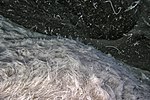related and have been promoted to phyla in their own right. The term Aschelminth is now generally only used as an informal name for any member of the... 2 KB (230 words) - 05:02, 10 January 2024 |
that a thick cuticle with repetitive pattern is characteristic of some aschelminth groups, but of virtually no other extant animals apart from arthropods... 24 KB (2,720 words) - 21:27, 10 March 2024 |




